Among the broken bottle glass and fragments of drinking vessels recovered from this feature were remnants of 21 artifacts that mark the advances in home lighting that occurred during the nineteenth century. People living in this period witnessed a series of changes that brightened their home life, as lighting progressed from the flicker of candlelight through whale oil, camphene, kerosene and gas lamps to electric lighting. 1 Even with the rapid changes in lighting technology during this time period, most households used different types of illumination simultaneously, depending on which rooms were being lit. Gas light was not as portable as earlier forms, making it necessary to rely on whale oil or kerosene hand lamps when moving from one room to another at night. The lighting devices recovered from this shaft feature trace some of the advances in lighting during the nineteenth century.
Bobeche
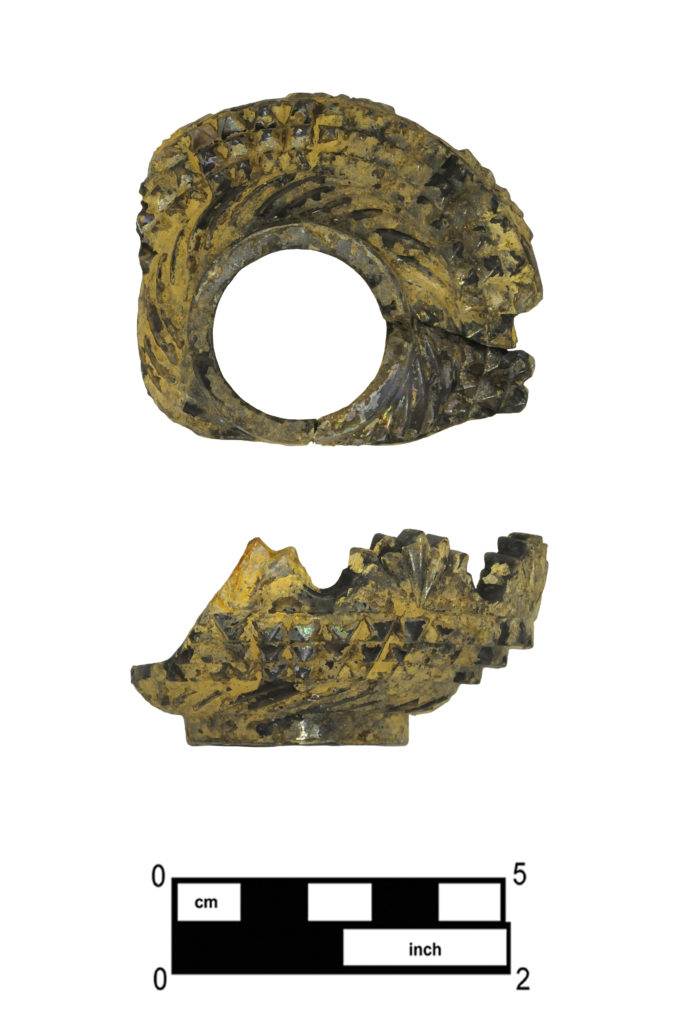
Two pieces of a single pressed-glass bobeche provide the only evidence of the use of candles in lighting this residence (Cat # 4.24.392). A bobeche is a small dish-shaped piece of glass or metal with a round perforation through the center. When positioned around a candlestick or chandelier, the bobeche served as a shield to catch melted wax and prevent it from dripping onto furniture, carpets, or guests. This example measures 3 inches in diameter, with a center opening of 1 inch and an overall height of 1.2 inches. Although now discolored from long exposure to organic material in the privy soil, this bobeche was made from colorless lead glass. The pressed decoration combines a scalloped rim made up of fan shapes, with three rows of block diamonds and a wide band of diagonal ribs around the lower edge near the socket flange. This pattern was offered in the Launay, Hautin et Cie catalog of 1840, where it is identified as No. 1498. 2 The Launay, Hautin et Cie firm was located in Paris and served as the agent for several French glassworks. The letter code above the catalog illustration identifies this as a pattern manufactured by the glass factories of Baccarat and St. Louis. A wide variety of French glass tableware and lighting items were available from various merchants in Philadelphia at this time.
Glass Lamps
Three glass lamps recovered from this feature are forms that were commonly used for lighting with whale oil or burning fluid. The burners used on whale oil lamps had a wick tube or tubes that extended down into the font to warm the thick oil and keep it fluid enough to burn. Wick tubes for burning fluid extended up away from the font to keep the flame at a distance from the combustible fuel. These burners also had cone-shaped metal caps connected via a small chain to each wick holder to cover the end of the tube and prevent the fuel from evaporating. Some lamps were later converted for use with other fuels by changing the metal burner.
Chamber or Sparking Lamp
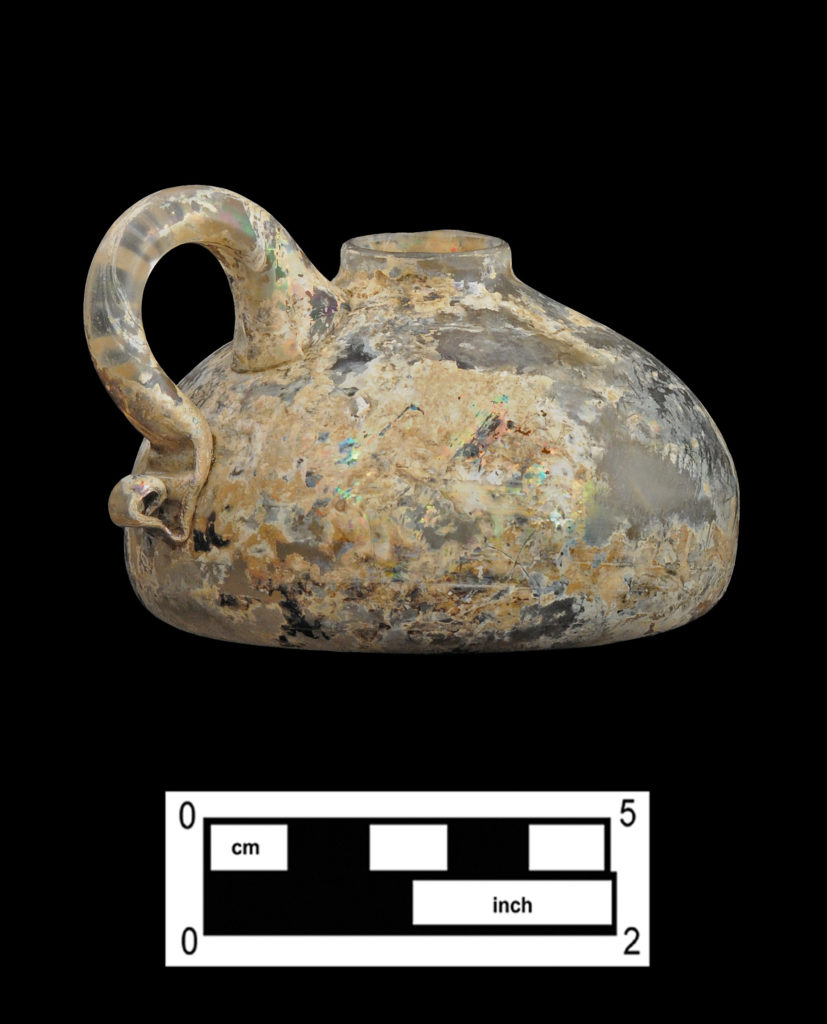
This small colorless lead glass lamp measures 2 inches in height and 3 inches in diameter (Cat # 4.31.4). Free-blown glass lamps of similar form date from the 1820s through 1840s. 3 Because they were often used in the bed chamber, these small lamps were also called “chamber lamps.” 4 Lamps with handles allowed the light to be transported from room to room or up a stairway at night. While this lamp appears simple in form, some elements of the design aided in the safe transport of both lamp and fuel. The wide flat base provided stability when setting the lamp down in a new location and prevented it from tipping over accidentally. In addition, the pinched end of the applied handle was designed to be functional as well as ornamental. The tooled indentation at the bottom edge of the handle provided a rest for the finger and a means to steady the lamp during transport. With the index finger through the loop and another resting against the lower edge of the handle, the thumb is naturally positioned at the mid-point of the handle at a distance from the flame.
Small lamps like this one are also referred to as “sparking” lamps, after an old term for courting or dating. According to folklore, small oil lamps were sometimes used to determine the length of a young man’s visit with his sweetheart. When the lamp ran out of oil and the flame flickered out, it was time for the date to end. 5 Period newspapers do not use the term “sparking lamp,” although a few news stories describe legal action brought by fathers or jilted lovers seeking compensation for food, fuel for heating a room, and the whale oil used in the lamp during sparking.
Many glassworks manufactured glass hand lamps, and some were being made locally at Union Glass Works in Kensington. Although there are no illustrations or descriptions to use for comparison, some account books from Philadelphia merchants dating from the 1830s list “night lamps” and “squat night lamps” among the glassware purchased from Union Glass Works. 6
Free-Blown Font with Pressed Standard
The mended portion of another colorless lead glass lamp measures approximately 8 inches in height with a font diameter of 2.5 inches and base diameter of 3.9 inches (Cat # 4.29.15, 4.34.44, 4.39.15). This lamp was found with a white metal collar secured in place. The remains of the burner consist of two round openings positioned close together—suggesting the double tubes of a whale oil burner.
This lamp has a thin free-blown font joined to a heavy pressed standard by a wafer-like piece of glass called a merise. The font features a floral motif cut with a stone wheel and left unpolished. Although only half of the font was recovered, the surviving decorative elements feature some distinct details (see illustration). The center of the font is encircled by a wavy stem with several linear lanceolate leaves projecting at slight angles from opposite sides. A single stylized flower is represented by six circular cut petals around a closely cross-hatched center. To the right of the flower is a single circle with seven rays projecting from the top, resembling a stylized thistle. A single ovate leaf positioned above the thistle features a series of cut lines, with three on the leaf to represent veins and a series emanating from both sides to the tip of the leaf. Three ovate leaves with this same detail are part of the cut motif on fragments of a lamp globe recovered from this feature and described in more detail later in this section.
Lamps with blown fonts of a similar shape are part of the collection of the Toledo Museum of Art in Ohio. 7 The museum examples are dated to between 1830 and 1845. One of the lamps with a plain blown font is identified as possibly manufactured at Boston and Sandwich Glass Works in Massachusetts. The other lamp with a cut decorated font was probably made at New England Glass Company. Another lamp with a similarly shaped cut font is illustrated in The Glass Industry in Sandwich, volume 2. 8
The base of the recovered lamp was pressed in a hexagonal mold with two vertical sections, and a cylindrical plunger was used to shape the hollow interior and hexagonal foot. A similar hexagonal base pattern is documented on candlesticks in the collection of the Corning Museum of Glass. 9
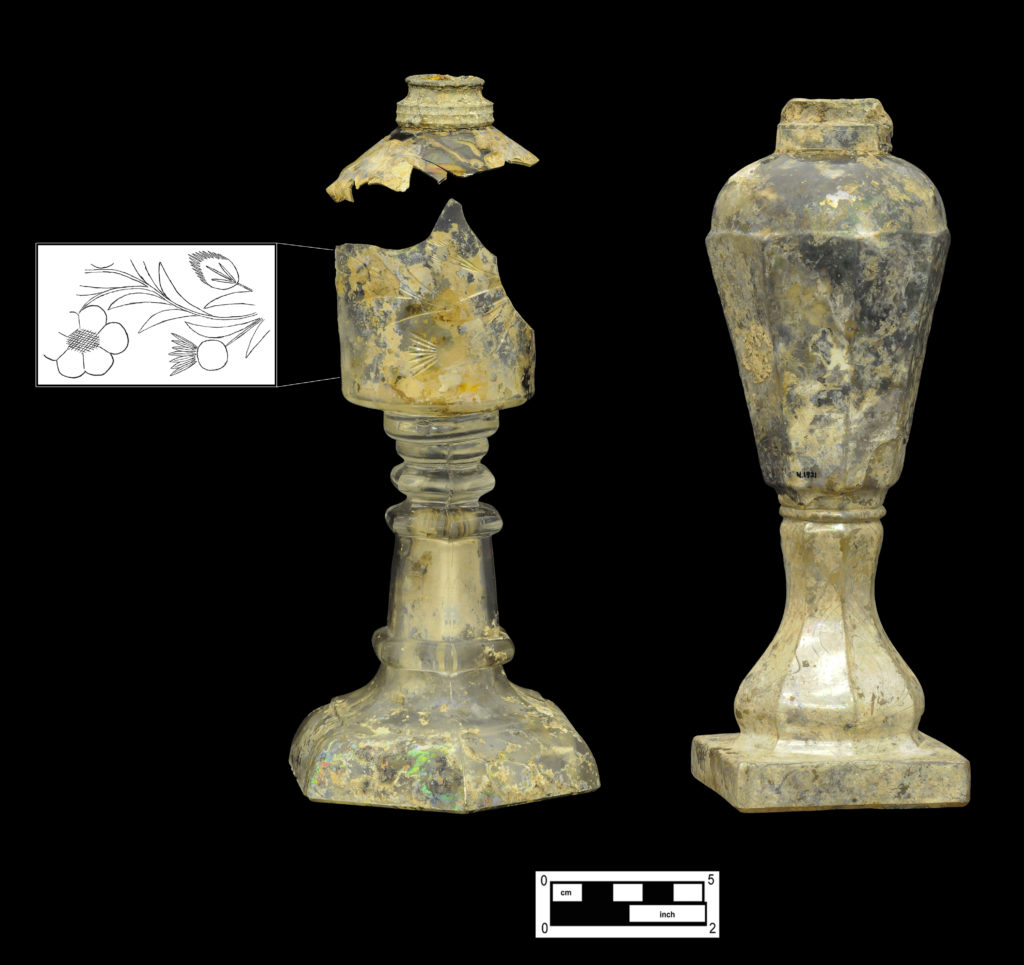
Pressed Octagonal Lamp
The other colorless lead glass lamp (height 8.8 inches) has an octagonal font connected by a single wafer to a pressed octagonal standard with a square base (Cat # 4.24.608, 4.29.16). The diameter of the font is 3.2 inches and the base measures 3 inches square. The pattern is similar but not identical to pressed lamps attributed to Sandwich or New England Glass Company. 10 The interior surface of the standard and base of this lamp was finished with a smooth plunger. Similar forms of whale oil lamps were in use from the 1840s through the 1860s. 11
The white metal collar that held the burner remains fastened securely to the top of the font. Lamp collars were usually cemented in place with plaster of Paris. 12 The projecting portions of the wick tubes are missing from this burner; however, the close proximity of the two wick tubes seems to suggest a whale oil burner.
Gas Bracket and Bracket Back
These mended fragments of brass pipe are part of a gas lamp bracket (Cat # 4.24.497). This type of bracket was designed to pivot from side to side, allowing the light to be repositioned. Extendable brackets were advertised as “swings” and were available with one, two, or three joints. Adjustable brackets were commonly used in bed chambers near mirrors, around desks, or in locations where close work required a more flexible light source. 13 The head of this gas burner was too corroded to determine the exact shape of the opening. The pipe features an embossed decoration resembling vines and leaves repeating along its length, while the cast extension connector and the gas burner are embellished with daisy-like flowers and the edges are trimmed in a cord-like design.
A stamped disk of copper alloy (2.95-inch diameter) with a round opening at the center (0.7-inch diameter) is most likely the bracket back for the recovered gas pipe (Cat # 4.29.62). The bracket back is a piece of hardware that covers the hole in the wall where the bracket connects to the gas pipe. 14 This bracket back was ornamented with a stamped stylized leaf and scroll motif, and patches of the original gilt finish are evident on the front surface.

Copper Alloy Shade Holder
This thin, wheel-shaped piece of hardware—stamped from copper-alloy sheet metal—is a lamp shade holder (Cat # 4.27.145). The two small tabs and a single small screw projecting from the outer edge of the holder served to secure the glass shade or globe in place. This shade holder measures only 2.75 inches in diameter and would have held a shade with a small opening or throat. Shade throats measuring 3.5 inches or greater in diameter are dated to sometime after 1876. 15 The 1902 Sears, Roebuck catalog advertised “Brass globe holders for gas fixtures” available in two sizes: 4 and 5 inches. 16
Lamp Shades and Globes
Quite a bit of variety was evident among the fragments of glass lamp shades and globes recovered from this feature. There are several different types of globes with elaborate cut decoration, as well as various opaque white glass shades.
Cut Bell Shades
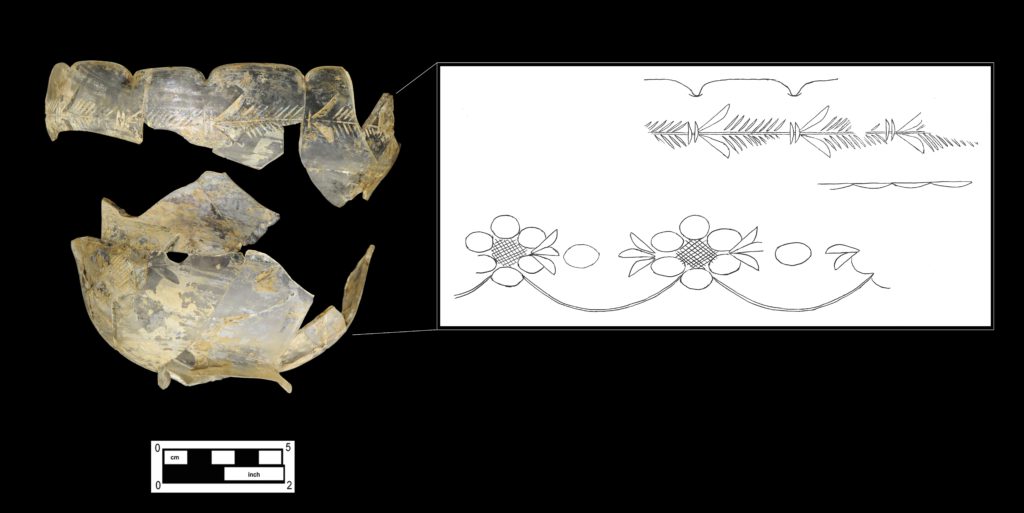
Portions of two bell-shaped shades formed of colorless glass were recovered. One shade is identified by only two sherds, featuring the remains of a decoration consisting of two bands—one of repeating small ovals, the other of slightly larger round shapes (Cat # 4.24.321). Although there is not enough of the throat remaining to obtain a measurement, when compared with other examples, this shade appears narrow. A more complete shade of colorless, lead glass features a distinctive shape illustrated and advertised as “Cut Bell” in a catalog of the Pittsburgh-based McKee Brothers glassworks, dated 1859/1860. 17 The throat measures 1.8 inches in diameter; the opposite end is 7 inches, with a height of 5 inches (Cat # 4.24.395). The wide end was crimped using a handheld tool to form a scalloped edge. The exterior surface of this shade was ground on a stone wheel prior to creating the cut design. The cut decoration on this shade consists of a band of stylized leaves around the wide scalloped edge (see illustration). Most of the leaves are the same size and project at angles from either side of a narrow horizontal line. Each group of leaves is segmented by two large leaves projecting in the same angular fashion, followed by two short vertical cuts. The resulting design may represent a stylized wreath. The shoulder and body of the bell are decorated with a band of alternating flowers and ovals. The floral design consists of six ovals arranged in a circle around a tightly cross-hatched center. Each flower has two sets of three leaves projecting from each side, and the flowers are connected via an arched line that extends onto the shoulder of the shade.
Cut Globes
Portions of four different colorless globe-shaped glass shades were identified from this feature. Each of the globes was embellished with cut decorations that are illustrated here to capture the details.
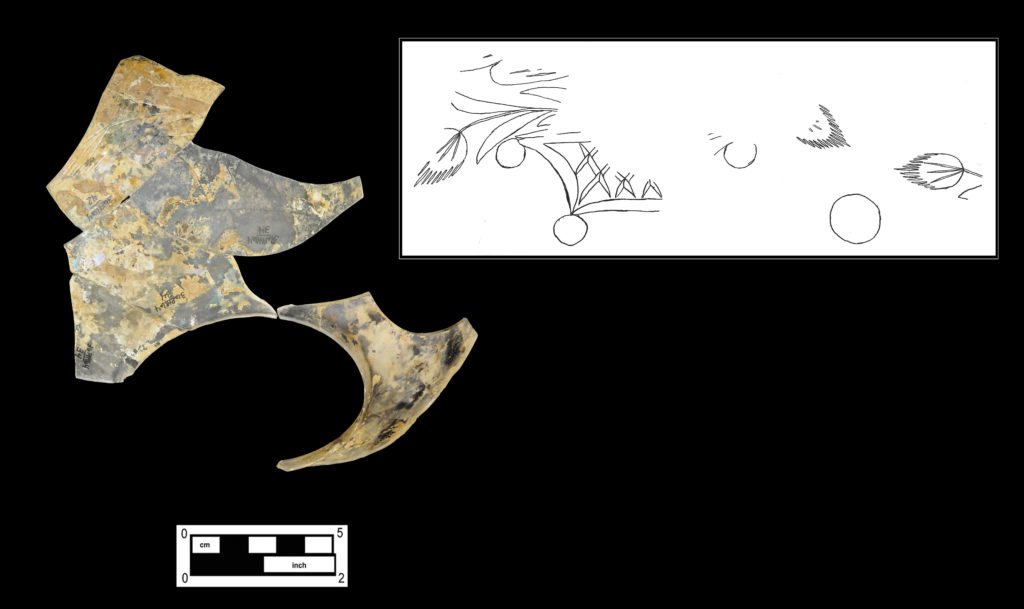
One colorless lead glass globe is represented by several thin fragments that mend and additional pieces that appear to be from the same shade. The throat of this globe was fire polished and mends to nearly complete, measuring 3 inches in diameter. The exterior surface of this globe was overall etched and some fragments feature portions of stylized baskets represented in a cross-hatched pattern (Cat # 4.34.36). Large flowers project from the tops of the baskets, and some of the leaves are similar to a single ovate leaf on the whale oil lamp font described previously. There are portions of three ovate leaves with three cut veins and a series of narrow cuts emanating from the tip of each leaf.

A second colorless lead glass globe has a throat dimension of 2.5 inches in diameter (Cat # 4.24.441). The top edge of this flared throat was ground flat. The glass is thicker and the exterior of this globe was etched. The cut decoration consists of a band of crescents connected at the tips via cut round shapes. A single eight-pointed star was cut inside each of the crescents, with a band of cross-hatched diamonds positioned above, near the center of the globe.
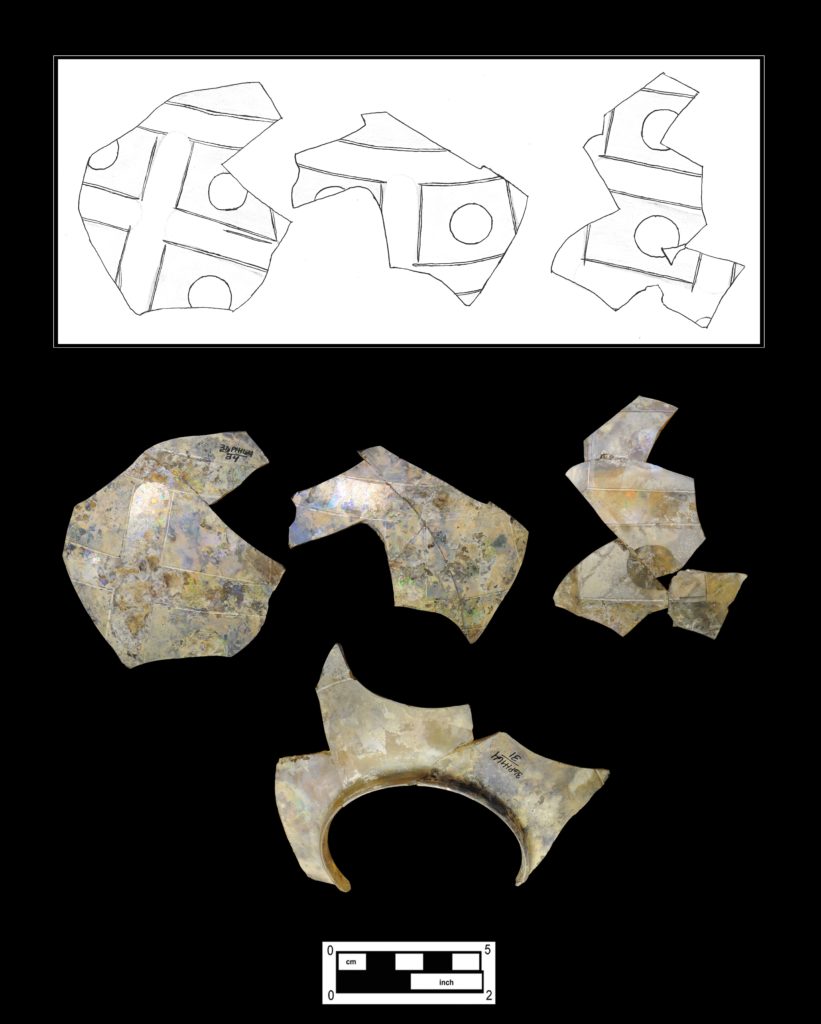
The third globe was also formed of colorless lead glass, with a fire-polished throat of approximately 2.7 inches in diameter (Cat # 4.29.84). This thin globe was overall etched and features a cut design of wide bisecting bands that create a box-like or checkerboard pattern, with a single round cut at the center of each.
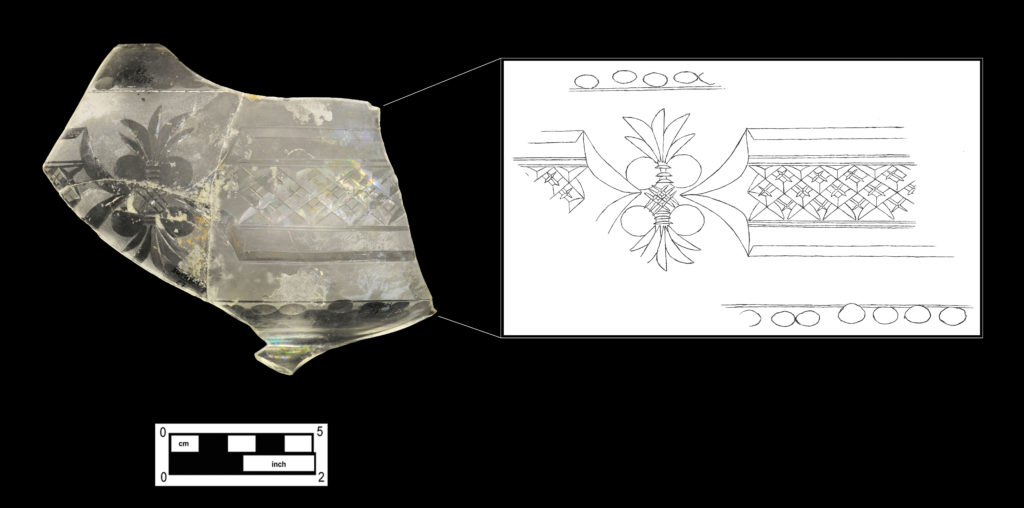
Formed of thick colorless glass, the forth globe does not fluoresce for lead under the black light (Cat # 4.27.122). This globe has a height of 4.75 inches, with the top edge measuring 6.5 inches and a flanged, fire-polished throat measuring 4.5 inches in diameter. The wide etched band around the center of this globe features an elaborate cut decoration (see illustration).
As noted previously, the dimension of the throat of the shade used on gas lights provides some assistance in determining the date of production. “Wide-throated shades were not made until after 1875, but by the early 1880’s they had almost entirely supplanted the small-based type, since the wider diameter of their bases greatly reduced flickering by providing an even flow of air to the burner tips.” 18 It is interesting to note that although some cut design elements were similar, none of the shades or globes recovered from this feature are an exact match to those illustrated in the several glass and lamp catalogs consulted to date.
Acid-Etched Floral
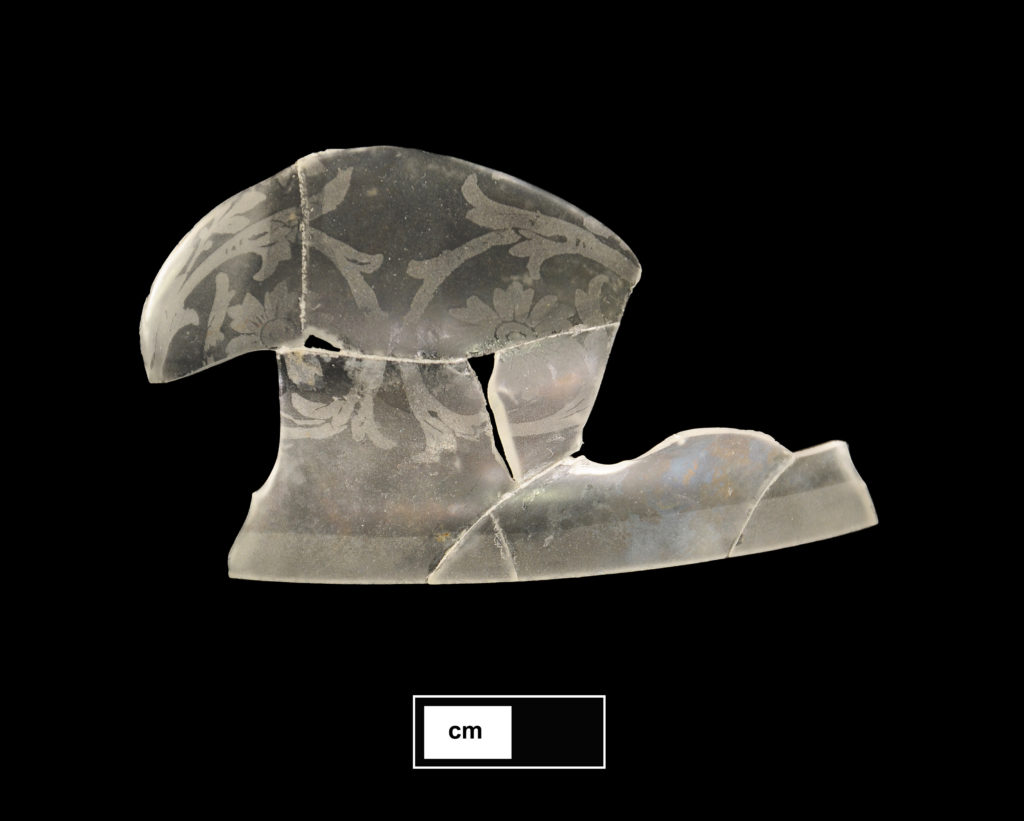
Another shade is represented by a few pieces of the rim or throat and portions of a fluted or “ruffled” shoulder (Cat # 4.24.439). This example appears to be double etched using acid, with an overall application on the exterior surface, an etched floral motif on the shoulder, and a horizontal band around the rim. The top edge of the throat was ground and measures approximately 4.5 inches in diameter. “The use of hydrofluoric acid to etch a matte finish on glass began about 1870 and continued to be popular for the rest of the century.” 19
Opaque White Shades
Four different types of opaque white glass shades were found, all probably dating to the 1870s or later, when this style of shade became popular.
Crimped Shade
This opaque white glass shade features a crimped fluted outer edge (Cat # 4.24.468). The shade measures 8 inches in diameter, with a center opening of 3 inches and height of 1.5 inches. Similar crimped opaque shades were used on kerosene, gas, and electric lighting devices to decrease glare and concentrate light downward for reading or close work. This type of shade was illustrated in the Butler Brothers catalog of 1903, offered as “shades for gas lamps fits all incandescent, common or gasoline burners.” 20

“Ring Top” Shade
Portions of another large opaque white shade mend sufficiently to provide information on form and dimension (Cat # 4.24.470). This incomplete shade measures 11 inches in diameter with a throat of about 3.5 inches and height of just over 5 inches. This type of shade was manufactured by many glassworks and available from mail-order catalogs. The recovered example is similar to the “cone shaped” shade illustrated in an undated Gillinder and Sons catalog from the late nineteenth century. Boston and Sandwich Glass Works also manufactured this type of shade, in seven sizes measuring from 6 to 12 inches. Similar shades were offered in a range of sizes and available plain or with painted designs in the Montgomery Ward & Company catalog of 1897. 21 “Undecorated they were sold to be put on reading lamps.” 22
Domed Shade
Portions of a single opaque white shade formed of pressed glass were recovered (Cat # 4.24.466). This dome-shaped shade, with a height of only 2 inches, has a throat diameter of 3 inches and measures 5 inches in diameter on the wide end. The throat has a small straight flange and both edges were lightly ground, leaving them with a rough finish. Shades of this type were used on small lamps, cigar lamps, and on chandeliers. While there is no evidence that this example was decorated, some domed shades were available with painted designs.
Globe
Some pieces of a large, thin opaque white globe mend showing a flared throat measuring 2.8 inches and a rim diameter of approximately 7 inches (Cat # 4.24.469).
Lamp Chimney
The bulging body of this lead glass lamp chimney suggests that it was used on a kerosene lamp (Cat # 4.24.372). A chimney was necessary on lamps burning kerosene to “provide the draft for adequate air supply and a steady flame.” 23 Glass chimneys were sensitive to sudden drafts, which frequently resulted in breakage. 24 Hand crimping on the upper rim of chimneys began after 1870, and machine crimping was introduced by 1879. 25 This chimney appears to be machine crimped and the glass is slightly thicker than examples recovered from other parts of this project. The wide collar at the base of this example reflects a change in chimney shape dating from 1873 or later. The straight rim allowed the chimney to seat within a four-pronged holder.
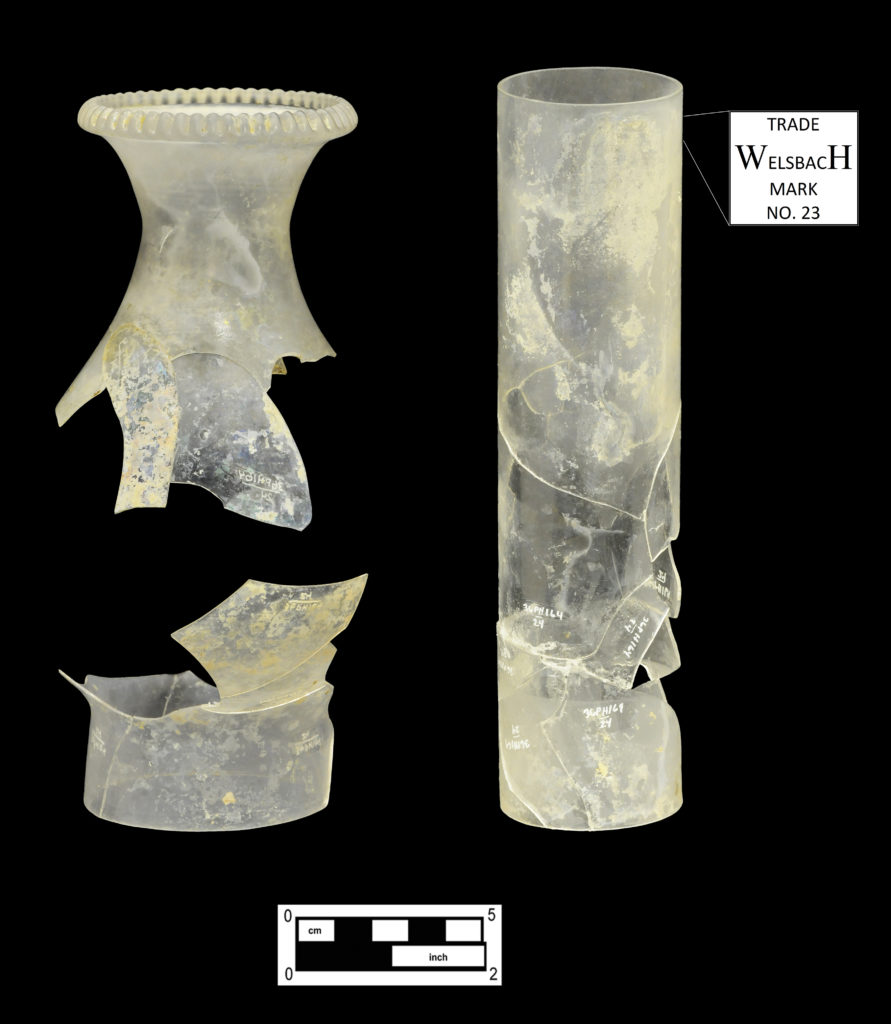
Welsbach Chimney
Two colorless glass chimneys of a distinct cylindrical shape were recovered; the more complete example measures 8 inches in length and approximately 2 inches in diameter, with an etched band around the bottom edge (Cat # 4.24.389 and 4.24.471). Close inspection of this chimney revealed a faintly etched label identifying it as “Welsbach Trade Mark No. 23.” The chimneys were designed for use with the Welsbach incandescent gas burner. “In the burner with a Welsbach mantle there was little flame, and the source of light was high and narrow. This permitted the use of a narrow glass chimney, which accentuated that draft and hence the combustion.” 26
An article in the Philadelphia Inquirer, dated November 21, 1887, announced:
A large number of persons interested in the manufacture of illuminants witnessed an exhibition of the system of improved lighting of the Welsbach Incandescent Gaslight Company yesterday, which is about to begin the manufacture of the new burners at Gloucester, N.J…” 27
Although the notice continued with a description of the mantle, an article published April 10, 1888, in another Philadelphia paper is easier to understand:
The burner consists of a Bunsen burner which is surrounded by a cylinder or mantle, as it is called, four or five inches long and two in diameter, made of knitted cotton which is dipped into a solution, dried and afterward consumed by a hot flame until only a cinder retaining the original form of the oxides of the metals remains. This is suspended by means of wires around the burner, which, when lighted, glows with a white heat, giving a beautiful steady light. 28
Carl Auer Von Welsbach from Vienna, Austria-Hungary, received U.S. Patent number 377,699 on February 7, 1888, for a compound for making incandescent devices. He had previously received patents for this invention in various countries—the first from France was dated November 4, 1885. His U.S. patent detailed the use of “the earthy oxides of lanthanum and zirconium” to create the incandescent mantle. 29
Among the benefits ascribed to the Welsbach burner was that it produced a brighter, steady light using less gas, created less heat and smoke, provided a white glow resembling electric light, and that the fixture was easy to connect to an ordinary gas fitting. 30 The Welsbach burner was commonly used to update older gas fixtures.
Dewdrop/Hobnail Shade
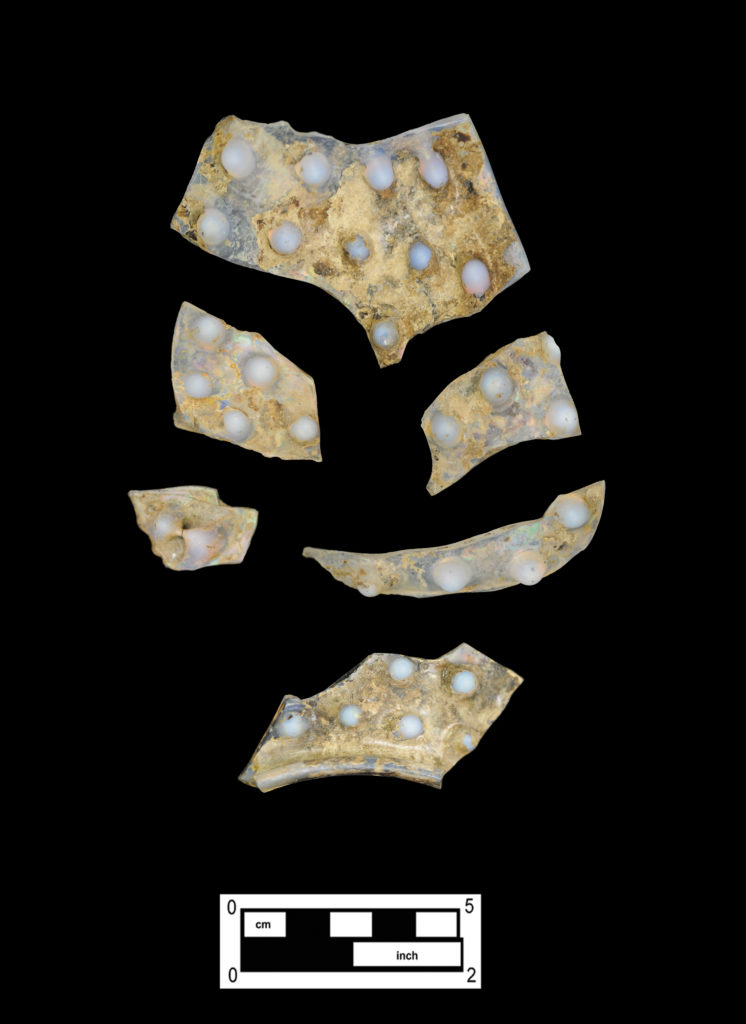
Several pieces of a single shade display the distinctive “dewdrop” decoration commonly known as “hobnail” (Cat # 4.24.383). The fragments are colorless glass with opalescent or semi-opaque white hobnail projections. A patent (U.S. Patent 343,133) for the manufacture of opalescent glassware was secured by William Leighton Jr. and William F. Russell for Hobbs, Brockunier and Company on June 1, 1886. Although this patent introduced an improved method for pressing glass to produce an opalescent effect, it describes the mold-blown technique that was already in use by skilled glass blowers.
This opalescent effect is produced by whitening or rendering semi-opaque certain parts or points of a body otherwise transparent, and the method heretofore employed therefore consisted in mixing with the glass suitable ingredients whereby the glass will be whitened or rendered semi-opaque by cooling and reheating, blowing a ball of glass of such composition in a mold having numerous recesses or indentations in its molding face, such recesses or indentations being of such size and depth as to rapidly cool the portions of glass forced therein. The ball of glass thus formed with numerous projecting bosses or nodules on its surface is removed from the mold and allowed to cool, and is then reheated. As the projections or nodules have been cooled to a greater degree than the body of the glass, by reason of the comparatively greater surface exposed to the cooling action of the mold and exposure to air, the subsequent reheating will render the nodules or projections white or semi-opaque without materially affecting the body of the glass… 31
The recovered shade fragments appear somewhat bell shaped with a ruffled or fluted edge. This shade is similar to a style of hobnail shade illustrated on kerosene lamps offered in the 1886–1887 catalog of the Meriden Britannia Company. 32 Many glass factories produced hobnail decoration on glass and it remained popular well into the twentieth century.
Amber Greek Key and Flower Shade

Fragments of a lamp globe made of a light amber-colored glass feature an embossed design of daisy-type flowers and leaves with a wide band of Greek Key (Cat # 4.24.447). The throat of this shade has a thick flared flange with an approximate diameter of 5 inches; the opposite edge has a straight finish measuring about 6 inches in diameter. The raised design elements of this shade were ground or frosted, possibly via sandblasting.
Other Artifacts of Lighting
Two additional artifacts—a slag glass spill vase and wooden match sticks—are associated with lighting and are described in more detail in the section on objects in the parlor.
References
- Nadja Maril, American Lighting 1840–1940 (Atglen, PA: Schiffer Publishing, Ltd., 1995), 7. ↩
- Pamela Wessendorf, “Launay Hautin 1840 2me Partie Planche 32, ” accessed May 15, 2014, http://www.glas-musterbuch.de/Launay-Hautin-1840.20+B6YmFja1BJRD0yMCZwcm9kdWN0SUQ9Nzg1JnBpZF9wcm9kdWN0PTIwJmRldGFpbD0_.0.html. ↩
- Lura Woodside Watkins, “American Glass Lamps,” in Lighting in America: From Colonial Rushlights to Victorian Chandeliers, ed. Lawrence S. Cooke (Pittstown, N.J.: The Main Street Press, 1984), 55. ↩
- Kenneth M. Wilson, New England Glass and Glassmaking (New York, N.Y.: Thomas Y. Crowell Company, 1972), 249. ↩
- George S. McKearin and Helen McKearin, American Glass (New York, NY: Crown Publishers, Inc., 1948.), 378; Wilson, New England Glass and Glassmaking, 249. ↩
- Mary M. Cheek, “The Cooperative Venture of the Union Glass Works, Kensington, Pennsylvania 1826–1842,” Journal of Glass Studies 39 (1997), 128, 138. ↩
- Kenneth M. Wilson, American Glass 1760–1930, Vol. I (New York, NY: Hudson Hills Press, 1994), 323, plate 389, and 331, plate 408. ↩
- Raymond E. Barlow and Joan E. Kaiser, The Glass Industry in Sandwich, Volume 2 (Windham, NH: Barlow-Kaiser Publishing Co. Inc., West Chester, PA: Schiffer Publishing, 1989), 79, plate 2084. ↩
- Jane Shandel Spillman, American and European Pressed Glass in The Corning Museum of Glass (Corning, N.Y.: The Corning Museum of Glass. 1981), 226. ↩
- Barlow and Kaiser, The Glass Industry in Sandwich, Volume 2, 82, plate 2092; Spillman, American and European Pressed Glass in The Corning Museum of Glass, 233, plate 914. ↩
- Spillman, American and European Pressed Glass in The Corning Museum of Glass, 233. ↩
- Jane S. Shandel, “Glass Lighting Devices,” in Lighting in America: From Colonial Rushlights to Victorian Chandeliers. Ed. Lawrence S. Cooke (Pittstown, New Jersey: The Main Street Press, 1984), 63. ↩
- Denys Peter Myers, Gaslighting in America: A Guide for Historic Preservation (Washington, D.C.: Heritage Conservation and Recreation Service Publication Number 3, 1978), 21. ↩
- Maril, American Lighting 1840–1940, 46. ↩
- Myers, Gaslighting in America: A Guide for Historic Preservation, 45. ↩
- Sears, Roebuck, Sears, Roebuck Catalogue, 1902 Edition (New York, NY: Republished by Crown Publishers, Inc., 1986), 663. ↩
- M’Kee and Brothers, M’Kee Victorian Glass Five Complete Glass Catalogs from 1859/60 to 1871 (New York, NY: Dover Publications, 1981), 27. ↩
- Mitchell, Vance & Company, Picture Book of Authentic Mid-Victorian Gas Lighting Fixtures (New York, NY: reprinted Dover Publications, Inc., 1984), vi. ↩
- Wilson, American Glass 1760–1930, Vol. I, 504. ↩
- Craig S. Schenning, A Butler Brothers Catalog Collection “Our Drummer” 1896–1906 (Hampstead, Maryland: Old Line Publishing Reference Book, 2009), 72. ↩
- Montgomery Ward & Co., Montgomery Ward & Co. Catalogue and Buyers’ Guide Spring & Summer 1895 (New York, NY: Dover Publications, Inc., 1969), 552. ↩
- Barlow and Kaiser, The Glass Industry in Sandwich, Volume 2, 131. ↩
- Lowell Innes, Pittsburgh Glass 1797–1891 (Boston, MA: Houghton Mifflin Company, 1976), 314. ↩
- Innes, Pittsburgh Glass 1797–1891, 314. ↩
- Pearce Davis, The Development of the American Glass Industry (Cambridge, MA: Harvard University Press, 1949), 155. ↩
- Loris S. Russell, A Heritage of Light (Toronto: University of Toronto Press, 1968), 298. ↩
- “The New Incandescent Light,” Philadelphia Inquirer, November 21, 1887, p. 1, Genealogy Bank, subscription database accessed August 2016, http://www.genealogybank.com. ↩
- “The New Incandescent Light Company,” The Times (Philadelphia, PA), April 10, 1888, p. 4, Newspapers.com, subscription database accessed August 2016, http://www.newspapers.com. ↩
- United States Patent Office, Carl Auer Von Welsbach Patent No. 377,699, February 7, 1888, Google Patents accessed September 2016, https://patents.google.com/patent/US377699A/en?q=welsbach&sort=old. ↩
- “New Way of Burning Gas,” Boston Herald, February 16, 1887, p. 1, Genealogy Bank, subscription database accessed August 2016, http://www.genealogybank.com. ↩
- United States Patent Office, W. Leighton, Jr. and W.F. Russell Patent No. 343,133, June 1, 1886, Google Patents accessed September 2016, https://patentimages.storage.googleapis.com/pdfs/1d4e01a2360f4dae5de4/US343133.pdf. ↩
- The Meriden Britannia Company, The Meridan Britannia Silver-Plate Treasury the Complete Catalog of 1886–7 (New York, NY: Dover Publications, 1982), 215, 218. ↩







